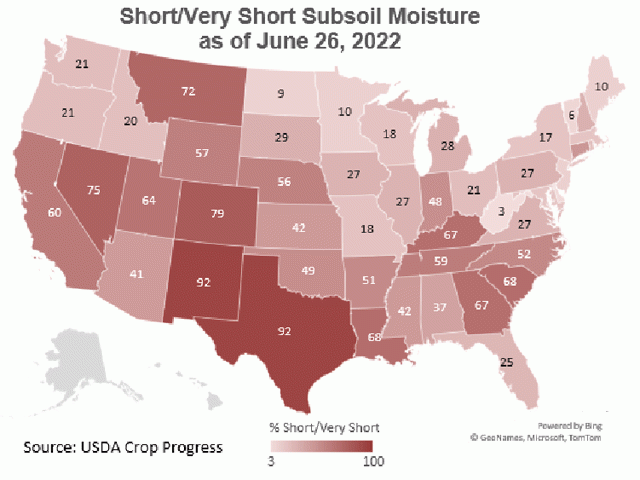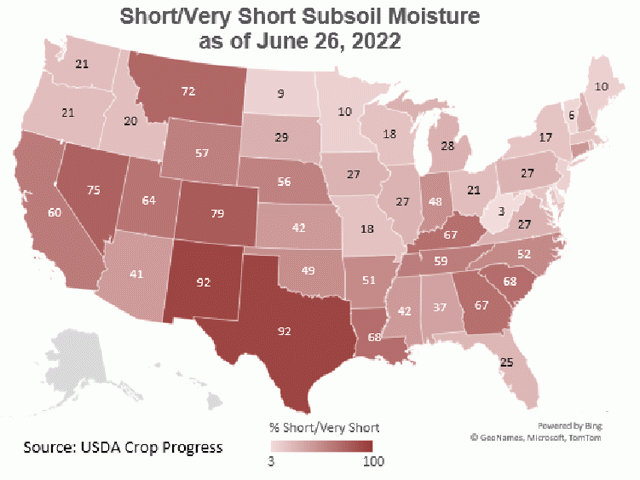Ag Weather Forum
Flash Drought Concerns Growing for Corn Belt
Driving through my part of Minnesota over the weekend, it was noticeable that corn appears to be in survival mode. The telltale signs of pineapple-looking curled leaves and moisture stress were apparent. You can find more about what that means here: https://www.dtnpf.com/…
I did not recall that my area was in drought. We have had less frequent and lighter precipitation lately, but I did not remember being in drought. When I went home, I looked at the drought monitor (https://droughtmonitor.unl.edu/…), and my eyes were not deceiving me. On the latest map, released on June 23, my area had just been placed in the D0 or abnormally dry category for the first time since April 12. Abnormally dry, sure, but not in drought. Being on sandy soil, I did not give my crispy-brown grass much thought. I had chalked it up to my soil texture. But this year, my grass looks just as bad as when I moved in the same time last year when my area was flirting with D2 drought.
But given all the heat and dryness our area has been in over the last couple of weeks, it should be no surprise to me -- we are in a "flash drought."
As defined by NOAA here: https://www.drought.gov/…, flash drought is a "rapid onset or intensification of drought. It is set in motion by lower-than-normal rates of precipitation, accompanied by abnormally high temperatures, winds, and radiation (sunlight). Together, these changes in weather can rapidly alter the local climate."
And they are not kidding. Just a week ago, driving through the same areas on my way to run some errands, I was smiling as I drove past corn fields with rapid growth and good-looking, dark-green leaves. It was hot, breezy, and sunny, but I was happy that my part of the country was not suffering the same delayed effects of the wet spring many other parts of the Corn Belt found themselves in. I especially thought about those in the Red River Valley between North Dakota and Minnesota and wondered what fields looked like up there in comparison. But fast-forward a week, and I cannot believe how quickly the tides have turned. What first appeared to be a good thing to get some heat into the crop has quickly turned my area from one with ample moisture to one that is moisture-starved. It is looking more like 2021 in my area than what I thought it might be given the active spring pattern. But that is how flash droughts work.
P[L1] D[0x0] M[300x250] OOP[F] ADUNIT[] T[]
The heat has not been confined to south-central Minnesota. Much of the country has been in -- or in and out -- of near-triple-digit heat for the past two weeks. Somewhat stronger winds have brought that heat throughout most of the Corn Belt, and the lack of rain has meant plenty of sunshine. All three have combined in my area to produce a flash drought. DTN/Progressive Farmer Crops Technology Editor Pam Smith noted on her drive from Chicago down to Decatur, Illinois, this past weekend that corn looked like it needed a drink and leaves were curling. I suspect that many other areas around the Corn Belt down to the Southeast are noticing the same. On the same drought monitor, more areas of D0 began to pop up all over the central Corn Belt all the way into the Southeast.
Flash drought may explain some of the reduction in crop conditions from the latest USDA NASS Crop Progress report. You can find more information about that report here: https://www.dtnpf.com/….
A front that came through this weekend has saved much of the country from another week of heat stress. But that front did not bring enough showers to enough people. Smith's route through Illinois did get some of the needed rainfall, but more areas saw little to no benefit from the rains, just like my area.
Flash droughts work quickly. You may not think you are in one until it is too late. For those with access to irrigation, it becomes more important to keep tabs on your soil moisture and signs of stress so you can act quickly to relieve some of it.
For corn, the curling leaves are the telltale sign as the plant attempts to reduce its exposure to sunlight. For soybeans, the leaves flip over and become dull or silvery from the road, again as the plant attempts to reduce its exposure to sunlight. In wheat, it becomes difficult to tell from the road, but by walking the field, you will see plant leaves curling somewhat like corn with old leaves wilting. For all crops, the plant closes the stomata on the leaves, closing off the access for carbon dioxide to get in and water to get out. Without carbon dioxide, the plant shuts down photosynthesis and growth, leading to yield losses.
You can read more about the impacts of drought stress on corn, soybeans and wheat here:
https://crops.extension.iastate.edu/… and here: http://wheatdoctor.org/….
For those without access to irrigation, we pray for rain and heat relief. One prayer is being answered this week, as more of the U.S. is back to typical summertime temperatures. The rains are still going to be hit-or-miss, though. A front will settle down from Canada on June 28 and meander about the Corn Belt through the rest of the week. Showers will develop along it, but they will be streaky and spotty where thunderstorms develop. This setup tends to miss more areas than it hits. Next week, there are indications that the heat will increase again as the ridge that brought the high temperatures earlier in June shifts back into the Plains following the Fourth of July fireworks. More folks are likely to find heat and moisture stress building in their fields and pastures. And if areas have not seen the signs of flash drought yet, they may be around the corner as we head into the most critical time of year for crops -- reproduction.
To find updated radar and analysis from DTN, head over to https://www.dtnpf.com/….
John Baranick can be reached at john.baranick@dtn.com
(c) Copyright 2022 DTN, LLC. All rights reserved.






Comments
To comment, please Log In or Join our Community .